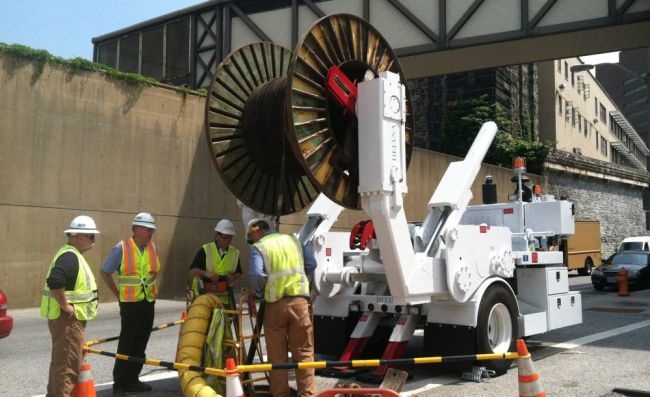
The Best Specs for Cable Reel Trailers
Cable reel trailers are bread-and-butter equipment for electric utility fleets. But that doesn’t mean they come in one size that fits all. Far from it. For one thing, there are at least a half dozen manufacturers producing these trailers. What’s more, these companies produce multiple models of cable reel trailers, with all being customizable to fit the exact capacity, productivity and safety requirements of individual utilities and contractors.
The right matchup between a trailer and the job at hand enables cable crews to get more done more safely in less time for a lower cost of operation. And pay strict attention to acquisition cost, which matters tremendously because cable reel trailers typically last at least 10 years; properly maintained ones have been known to roll for 20 years.
The upshot is that the “pay me now or pay me more later” principle is in play: Not weighing specs thoughtfully means the difference between spending thousands of dollars now or forking over tens of thousands of dollars later.
Manufacturer Suggestions
Given all that, let’s look at what items manufacturers recommend putting on your checklist to ensure your cable reel trailers are spec’d for your application, maintenance program and budget.
“Reel trailers can be a large investment,” said Mark Rapp, product manager for utility and telecom products at Felling Trailers Inc. (www.felling.com). “To ensure a long life, make sure you’re getting one that’s rated properly for the job. If the reels you’re hauling now are getting close to the rated payload capacity of the trailer being offered, step up to the next heaviest model.”
Given their complexity, considering every detail is critical. Greg Markert, business development manager for the Utility Group at Dejana Truck and Utility Equipment (https://dejana.com) provided this advice: “One should consider all of the work intended for the reel trailer and compare actual specifications and features, and capacities for lifting and pulling.” For example, he noted that when “using wooden reels for smaller cable operations, having wood reel adapters is a necessity.”
Markert also said that “for a cable puller, usually one empty reel for reclaiming old underground cable is generally used while one full reel is used for installing new cable. This is based more on the design of the machines than what can or will be hauled.”
Felling’s Rapp said that the reel diameter will determine the length of the trailer. Meanwhile, the reel weight will determine the axle package needed as well as the frame requirements. Reel width will determine the type of trailer needed. “Reel widths up to 64 inches in diameter can generally be hauled on a drop-deck trailer. Anything wider than that will need to be moved up to a deck-over-style trailer.”
Rapp also stressed that there are different options that enhance operability. For instance, tensioning brakes can be installed to tension the conductor as it’s being pulled off in overhead stringing applications.
He also pointed to the productivity boost from self-loading reel trailers that can be loaded by a single worker without the need for another piece of equipment. “When spec’d correctly, single-reel self-loading trailers can have payload capacities over 13,000 pounds. Multireel self-loading trailers generally have a much lower payload capacity per reel.”
According to Dejana’s Markert, cable puller trailers have self-contained hydraulic systems and rotate clockwise or counterclockwise to rewind. “Just as important is the pulling power of the pulling motors or rim drives in both directions,” he said. “Hydraulic motors will have the higher pulling power in both directions. Type of cable and length of pulls should determine needed pulling power. Trailers capable of a minimum of up to 40,000 pounds of pulling force can fill any application.”
Enhancing Use and Reliability
Markert offered a list of considerations to enhance trailer use and reliability. “Stabilizers are a safety must. Lifting heavy reels onto or off a pulling trailer can make the unit unstable. Stabilizers should always be used when loading, unloading or performing any pulling operation.
“A trailer’s maneuverability should also be considered when purchasing a trailer,” he continued. “Can the rear carriage be adjusted to be lined up with the manhole? Can the trailer turn in its own radius? What is the trailer’s ability to operate in tight spaces or substations?”
Markert noted that a “trailer with a high-torque drive motor and larger drive wheel will perform best on multiple surfaces and grades. And the use of air brakes in self-propelled mode should be considered for the safest trailer braking with loaded reels.”
Rapp pointed to rotating turret assemblies as an “extremely beneficial” enhancement. “A rotating turret allows parking the trailer parallel with the right-of-way. The turrets can then be turned to line up with the pull. This avoids having to jackknife the trailer to get properly lined up while keeping the right-of-way clear.”
He also advised that 12-volt DC is “more operator-friendly while hand pumps may be better where the trailer is only loading reels once or twice a day. If sitting unused for a long time, the hydraulic power unit’s battery could run down, but there are solar chargers that can keep the battery topped off.”
As for what’s coming down the road, Markert had this to say: “Working on lighter and stronger materials to manufacture trailers without sacrificing capacities and strength is something being looked at.”
About the Author: David Cullen is an award-winning journalist who specializes in covering the trucking industry. Based in Connecticut, he writes for several business publications.

